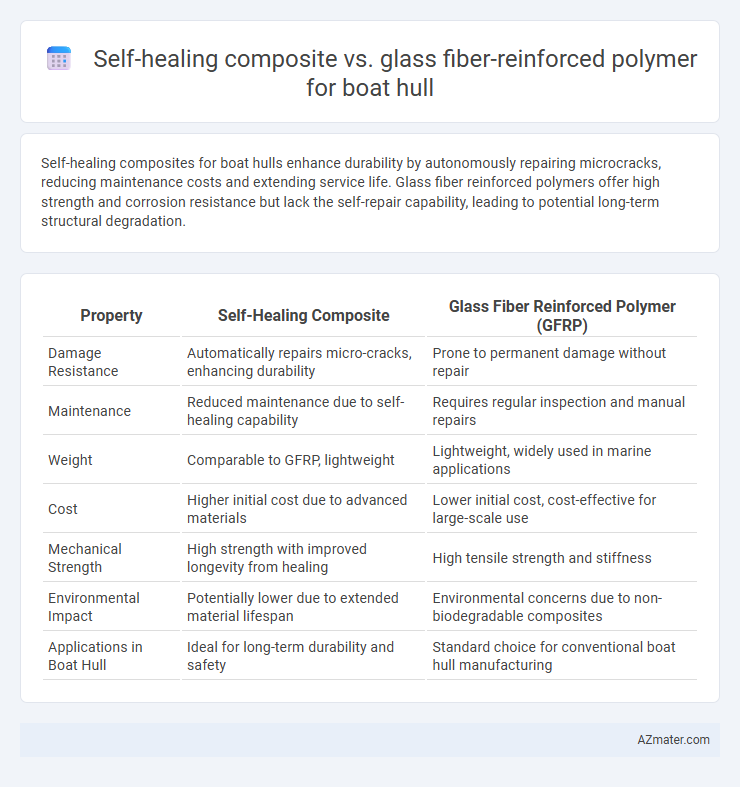Self-healing composites for boat hulls enhance durability by autonomously repairing microcracks, reducing maintenance costs and extending service life. Glass fiber reinforced polymers offer high strength and corrosion resistance but lack the self-repair capability, leading to potential long-term structural degradation.
Table of Comparison
| Property | Self-Healing Composite | Glass Fiber Reinforced Polymer (GFRP) |
|---|---|---|
| Damage Resistance | Automatically repairs micro-cracks, enhancing durability | Prone to permanent damage without repair |
| Maintenance | Reduced maintenance due to self-healing capability | Requires regular inspection and manual repairs |
| Weight | Comparable to GFRP, lightweight | Lightweight, widely used in marine applications |
| Cost | Higher initial cost due to advanced materials | Lower initial cost, cost-effective for large-scale use |
| Mechanical Strength | High strength with improved longevity from healing | High tensile strength and stiffness |
| Environmental Impact | Potentially lower due to extended material lifespan | Environmental concerns due to non-biodegradable composites |
| Applications in Boat Hull | Ideal for long-term durability and safety | Standard choice for conventional boat hull manufacturing |
Introduction to Boat Hull Materials
Self-healing composites offer advanced damage resistance by autonomously repairing microcracks, enhancing boat hull durability compared to traditional materials. Glass fiber reinforced polymer (GFRP) remains a widely used hull material due to its high strength-to-weight ratio, corrosion resistance, and cost-effectiveness. Innovations in self-healing composites aim to improve longevity and reduce maintenance, potentially surpassing the performance characteristics of conventional GFRP in marine environments.
Overview of Self-Healing Composites
Self-healing composites for boat hulls incorporate embedded microcapsules or vascular networks that release healing agents upon damage, enabling automatic repair and extending service life. Unlike traditional glass fiber reinforced polymers (GFRP), these composites offer enhanced durability by mitigating crack propagation and reducing maintenance costs. Their ability to restore mechanical integrity autonomously makes self-healing composites a promising advancement in marine hull materials.
Fundamentals of Glass Fiber Reinforced Polymers (GFRP)
Glass Fiber Reinforced Polymers (GFRP) are widely used in boat hull construction due to their high strength-to-weight ratio, corrosion resistance, and ease of fabrication. GFRP consists of glass fibers embedded within a polymer matrix, providing excellent tensile strength and durability against marine environments. Compared to emerging self-healing composites, GFRP offers well-established mechanical reliability, although it lacks the intrinsic damage repair capabilities that self-healing materials promise for extending hull life and reducing maintenance costs.
Mechanical Properties Comparison
Self-healing composites exhibit enhanced durability and damage tolerance compared to traditional glass fiber reinforced polymers (GFRP), enabling autonomous repair of micro-cracks that typically compromise boat hull integrity. While GFRP offers high tensile strength and stiffness, self-healing composites maintain comparable mechanical properties with the added benefit of extending service life through intrinsic repair mechanisms. These properties result in improved impact resistance and fatigue life for boat hulls, reducing maintenance costs and enhancing safety in marine applications.
Durability and Longevity Factors
Self-healing composites for boat hulls significantly enhance durability by autonomously repairing micro-cracks and preventing structural failure, extending service life beyond traditional materials. Glass fiber reinforced polymer (GFRP), while offering high strength-to-weight ratios and corrosion resistance, lacks the intrinsic damage-repairing capability, leading to progressive degradation under cyclic marine stress. The integration of self-healing mechanisms in composites addresses long-term maintenance challenges, improving hull longevity and reducing lifecycle costs compared to conventional GFRP hulls.
Damage Tolerance and Repair Capabilities
Self-healing composites exhibit superior damage tolerance for boat hulls by autonomously repairing micro-cracks and reducing crack propagation, thus extending service life compared to traditional glass fiber reinforced polymers (GFRP). While GFRP offers high strength and corrosion resistance, its repair typically requires manual intervention and structural downtime. The integration of self-healing agents in composites significantly minimizes maintenance costs and enhances hull integrity under dynamic marine conditions.
Weight and Performance Implications
Self-healing composites in boat hulls enhance durability by autonomously repairing micro-cracks, reducing maintenance needs and extending service life, while typically offering a lower weight compared to traditional glass fiber reinforced polymers (GFRP). Glass fiber reinforced polymers provide proven mechanical strength and impact resistance but generally result in heavier hulls, which can affect fuel efficiency and speed performance. Weight reduction through self-healing composites contributes to improved acceleration and maneuverability, directly impacting overall vessel performance and operational costs.
Resistance to Marine Environmental Conditions
Self-healing composites exhibit superior resistance to marine environmental conditions compared to glass fiber reinforced polymers (GFRP) due to their ability to autonomously repair micro-cracks caused by saltwater exposure and UV radiation, enhancing durability and lifespan. Glass fiber reinforced polymers, while strong and lightweight, tend to degrade over time from osmotic blistering and hydrolysis, especially under prolonged seawater immersion. The incorporation of microcapsules or vascular networks in self-healing composites significantly reduces maintenance costs and structural failures in boat hulls exposed to harsh marine environments.
Cost Analysis and Lifecycle Considerations
Self-healing composites for boat hulls typically exhibit higher initial material and manufacturing costs compared to glass fiber reinforced polymers (GFRP), driven by advanced resin systems and embedded healing agents. Lifecycle cost analysis reveals that self-healing composites reduce long-term repair expenses and downtime due to their autonomous damage recovery capabilities, enhancing durability and operational efficiency. While GFRP benefits from lower upfront costs and established repair techniques, its lifecycle expenses increase with frequent maintenance and potential structural failures over time.
Future Trends and Innovation in Boat Hull Materials
Self-healing composites are rapidly emerging as a transformative material in boat hull construction, offering enhanced durability by autonomously repairing micro-cracks, which significantly extends service life compared to traditional glass fiber reinforced polymer (GFRP). Innovations in nano-encapsulated healing agents within composite matrices are driving future trends toward more sustainable and maintenance-efficient marine vessels. The integration of self-healing technology with lightweight GFRP structures promises to optimize performance by reducing weight and environmental impact while improving resilience against mechanical damage and harsh marine conditions.

Infographic: Self-healing composite vs Glass fiber reinforced polymer for Boat hull
 azmater.com
azmater.com